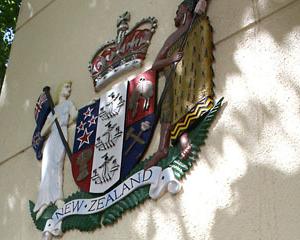
Jim Dynes was born with diesel running through his veins; a pioneer in New Zealand’s transport industry, his name was synonymous with hard work, integrity and tenacity.
He battled bank managers, bouts of cancer and the transport police in his drive to trucking success.

Jim and his siblings were raised in the rural community of Conical Hill, West Otago, on the family farm, where Jim’s love for hard work and trucks was ignited.
Jim attended Tapanui Primary School and later Tapanui District High School. Even then, work was never far from his mind. As soon as he got home from school, Jim would be straight into farm work, and weekends were much the same. He often completed his homework during lunchtime at school so he could get back to work the moment he arrived home. School, as Jim saw it, was something of an interruption to the real work that awaited him.
Jim’s passion for trucks began when a 1948 Austin truck arrived at the farm of his grandfather, JW. From that time, Jim and twin John were captivated by every truck that passed their way.

He often found himself hauling wool, hay and lime, gaining hands-on experience that would later serve as the foundation for Dynes Transport. Jim was never content to stay within the bounds of farm life; he had his sights set on something bigger, and his time behind the wheel was just the beginning of a lifelong career in the transport industry.
In 1966, Jim met Anita McKenzie at a dance in Waikoikoi. Jim and Anita became true partners in business as well as life. While Jim focused on growing the business, Anita handled much of the behind-the-scenes work, helping to keep everything running smoothly. Anita often jokes that she spent her life balancing Jim’s boldness with her practicality, but she was always proud of what they accomplished together.
Together, Jim and Anita built a successful business but also raised their three children, Debra, Peter and Shona.
In 1969, aged just 20, Jim and John took their first major step into the business world when they bought Cooper Transport. The deal wasn’t easy — being too young to qualify for a bank loan, they faced a significant hurdle right from the start.
Initially, Jim and John had their sights set on buying Pomahaka Transport but it was the owner of Cooper Transport, Jim Cooper, who recognised something special in Jim and John, their tireless work ethic and a genuine passion for trucks. Cooper offered to sell them his business and crucially, also guaranteed their loan until they turned 21.
Throughout the 1970s, Dynes Transport grew steadily, hauling timber, wool and lime. By the end of the decade, the company had established itself as a key player in the Otago region. In 1975, the brothers bought Taieri Carrying, a strategic decision to get around the 40-mile (64km) restriction carting was under in competition with rail.
Jim and John amicably split their businesses in 1979, John managing TD Haulage in Tauranga, while Jim continued to lead Dynes Transport in Tapanui. The partnership with John was one of mutual respect and shared passion, and it was a connection that remained throughout their lives.
Jim didn’t just run a business, he lived it. It wasn’t easy, especially in the early years, but he never let challenges stop him. His approach was simple: if someone said it couldn’t be done, he found a way to do it.
Jim was always thinking ahead, and his ability to see opportunities in every challenge allowed the business to thrive. The purchase of Taieri Carrying Co was a strategic move for Dynes Transport to expand its operations and strengthen its presence in the Dunedin area, through the licence that could cart against rail.

In the early years, Dynes Transport would do more work during the night "moonlighting", outrunning rail and the cops, than during the day. The police were always keeping an eye on them, but Jim had a way of staying one step ahead.
The Dunedin traffic cops would often ask the street-cleaners to keep an eye out for the Dynes trucks and if they spotted them to ring the police station. On the other side, there was a friendly bread delivery driver who would check the notice board at the
Gore police station and give Dynes a heads-up if it was safe to make their run.
He also devised a scheme with his son Peter. A weighbridge at the old Milburn cement plant was quite short, and trucks had to be weighed in two or sometimes three sections.
Jim and Peter devised a plan where Peter would stand opposite the truck while looking up the hallway. When the traffic cop was walking up the hallway, he’d scratch his head and Jim would move the truck slightly forward, just taking the wheel off the weighbridge to show the load as being lighter than it really was.
When the traffic cop began walking back towards them down the hallway Peter would look the other way, signalling to Jim that it was time to reverse the truck back on to the weighbridge. This worked for several years before they got caught.
Jim used to laugh about it in later years, saying it wasn’t just about bending the rules — it was about survival, and when it came to keeping the business going, nothing was going to stand in his way. On more than one occasion, they’d park their trucks at the rail yard, hiding under the tarps until the coast was clear. It was risky, but Jim’s philosophy was simple: the job had to be done, and he was going to find a way to do it, no matter the challenge.
There were times he felt he had to cross the line in servicing his farming clientele. During the boom times of the early to mid-1970s, when carting phosphate out to the farmers to spread on paddocks, the loading time for phosphate was 6am but trucking firms could only get permits that started at 10am.
Hence, Dynes delivered without a permit. The firm was caught and fined $3000, a sum the owner thought was ridiculous. Jim rang up the magistrate and said to him: "What are you doing mate? We’re trying to give a service and you nick us for $3000".
The judge said: "I suppose you’re right. We’d better do something about it," and in the end the fine was reduced to $300.
In 1976, Jim made a strategic choice to move away from the rural cartage that had been a cornerstone of the business and transition into the cartage of woodchips. This shift allowed Dynes to enter new markets and meet a growing demand in the forestry sector. The move to woodchip transport not only expanded the company’s capabilities but also solidified its reputation as a leader in specialised logistics. Jim’s foresight in making this change ensured the long-term success and growth of the company in aligning with the evolving needs of the industry.
But it wasn’t just the trucks that inspired him.
Jim was also a farmer at heart. In 1980, Jim and Anita bought their first farm of 110ha, where his love for the land blossomed. Over the years, the farm grew considerably, to just over 800ha.
By 1999, Jim’s son Peter had gradually started running Dynes Transport and building up his equity in the company, continuing the family tradition.
Jim faced life’s challenges head on. In 1983, aged 35, he was diagnosed with cancer of the lymph nodes, the first of three bouts he would suffer.
His wife’s capabilities were put to the test when Jim was ill. Anita’s daily activities included driving Jim the four-hour round trip to Dunedin for treatment, running the transport business, sorting the three children and helping with the lambing beat on a now increased additional neighbouring farm.
The purchase of Dynes Transport’s first Kenworth truck was a significant milestone for Jim. He always admired the Kenworth brand for the sheer power it brought to the road. When the opportunity arose to buy one, Jim didn’t hesitate. He believed that Kenworth trucks would handle the South Island terrain, represent the best in the industry and owning one was a statement of the company’s growth and ambition.
For Jim, the Kenworth wasn’t just a truck, it was a symbol of progress and a key asset in the future of Dynes Transport. He valued its strength and reliability, qualities he himself embodied, making Kenworth the perfect match for his business philosophy.
One favourite story that reflects Jim’s approach to life was when he took the bank manager to Bluff on a woodchip run. When they arrived, the truck needed to be unloaded using a ramp that tipped the entire truck and trailer unit sideways — a routine process for Jim, but a complete surprise to his passenger, who he left in the truck.
While the truck tipped, Jim just stood there laughing, enjoying the moment. And when they were done, rather than calling it a day, they decided to grab a meal at the local pie cart. It was closed, of course, but Jim being Jim, he convinced the owner to reopen just for them.
As Dynes Transport grew, so did the family’s involvement. Even though Jim stepped back from the day-to-day running of the company, which was taken over by his son Peter, he could never fully stay away. He was still behind the wheel of a milk tanker during the busy season, because for Jim, driving wasn’t just a job — it was who he was.
Jim’s impact on the New Zealand transport industry was significant. A true pioneer, he was always looking for ways to innovate and improve his business. He never chased recognition or accolades — Jim was more focused on getting the job done right.
Success, for him, was measured by the quality of his work, not by the praise he received.
Jim died on September 16, aged 76, father and father-in-law respectively of Debra and Paul McKenzie, Peter and Teresa, Shona and Bruce Robertson, estranged husband and friend of Anita, grandfather to Zach and Connor; Ronan, Stella and Kane; Sydney and Tait.












